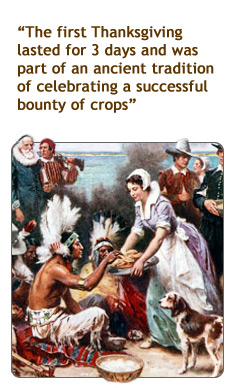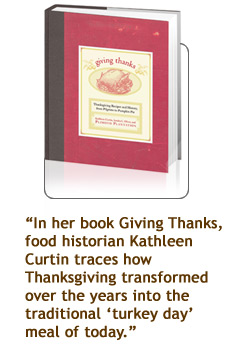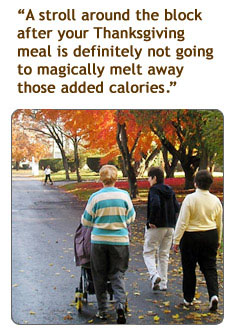 When you hear "gobble, gobble," what holiday comes to mind?
You probably think of Thanksgiving and a juicy brown turkey. But "gobble" also describes what many of us do too much on that day. After all, it’s become a holiday tradition to stuff not only the turkey but also ourselves.
 Consider the typical holiday fare of multiple servings of turkey and dressing with all the trimmings, rich casseroles and desserts like pumpkin pie, and then leftover helpings we scarf down while watching football. The platefuls of food most of us consume on Thanksgiving are often completely over the top.
The recommended daily intake for non-exercising men is 2,400 calories, and 1,800 calories for women. But on Thanksgiving, Americans tend to eat 3,000 - 7,000 calories -- excess food that can wind up becoming excess weight.
"The typical Thanksgiving feast can easily include more than an extra day's worth of calories and nearly four times the daily limit of fat," says Daniela Neri, a dietician at the University of Miami.
How did extreme over-eating become Thanksgiving tradition?
The original Thanksgiving tableIn 1621, the Plymouth colonists and Wampanoag Indians shared an autumn harvest celebration, often referred to as the first Thanksgiving in the colonies. However, the feast, which lasted for 3 days, was actually one event in a long and ancient tradition of celebrating a successful bounty of crops.
"Traditions of giving thanks for a successful harvest have occurred in agricultural communities worldwide for thousands of years," says food historian Kathleen Curtin from Plimouth Plantation in Massachusetts, a living history museum where you can step back in time and see recreations of how early Pilgrims lived -- and ate. (The museum’s name is spelled according to the old tradition.)
The famous event that occurred at Plymouth in 1621 was not even considered a "thanksgiving," per se, by the English colonists of that time. "The term ‘thanksgiving’ was reserved for a special and unusual providence from God -- the defeat of an enemy or the arrival of rain after a draught. A day of thanksgiving was spent in church, and a celebratory meal may have ended the day," says Curtin of Giving Thanks: Thanksgiving Recipes and History, from Pilgrims to Pumpkin Pie. "Later on, the Puritan thanksgiving did morph into an annual thanksgiving harvest feast, and that is where our modern holiday comes from."
The foods served at the famed 17th century harvest celebration at Plymouth looked far different than most modern Thanksgiving foods. Curtin points out that a variety of meats were most likely served, especially venison (brought by the Wampanoag) and wild geese and ducks hunted by the English. Other native birds, including wild turkey, might have been on the menu along with fish, eel, lobster, and shellfish. Some sources suggest the Pilgrims and their Native American guests might have also feasted on roasted seal.
Native fruits, nuts, and vegetables were included in the Pilgrim and Native American dishes. These most likely included corn, beans, squash, melons, plums, grapes, blueberries, cranberries, Jerusalem artichokes, leeks, wild onions, and walnuts. The English also cultivated crops like turnips, cabbage, parsnips, pumpkins, cabbage, and carrots. And Pilgrim cooks grew and used herbs, notably parsley, sage, rosemary, and thyme, says Curtin. Small quantities of goat milk, cheese, and eggs might have been on the table with a few English imports, such as vinegar, oils, salt, pepper, cinnamon, ginger, and nutmeg.
It’s unlikely, Curtin says, the Pilgrims served up something akin to our modern day stuffing. "However, roasted or boiled meats might have been stuffed with herbs or nuts," she says.
 Other foods we consider integral parts of today’s Thanksgiving tradition were definitely NOT part of the original Pilgrim/Native American feast, Curtin says. Cranberry sauce and anything else that required a lot of sugar or wheat flour were missing. And there were no sweet or white potatoes, and certainly no Jell-O or after dinner coffee or tea.
In her book Giving Thanks, Curtin traces how Thanksgiving transformed over the years into the traditional "turkey day" meal of today. In 1863, more than 200 years after what we think of as the first Thanksgiving in the New World, President Abraham Lincoln made Thanksgiving an official national holiday. By then, the Thanksgiving meal was well on the way to looking a lot like what we serve today: Common foods in Lincoln’s time were turkey with stuffing and gravy, potatoes, root vegetables, and mince, apple, and pumpkin pies.
"There were some differences, though," Curtin says. "Celery was an esteemed vegetable and may have been given a place of honor on the table. In addition to turkey and chicken pies, roast pork or beef were common. Oysters were also wildly popular, and barrels of them were shipped all over the country to be used in stuffing, creamed dishes, or eaten raw."
How healthy was the original Thanksgiving feast?"According to some research, the Pilgrim feast was lower in calories, especially calories derived from fat," says Neri, the dietician from the University of Miami. "They would prepare foods without high fat sauces or gravies. It is well known that a high-fat diet often leads to eating too much of tasty foods. So they probably wouldn’t have had the problem of overeating that too many Americans have today."
She adds that the lack of pies and sweets at the original Thanksgiving dinner meant the feast participants didn’t gorge themselves on simple sugars either. What’s more, they had no processed meats like hams and sausages, which can add unhealthy amounts of sodium to modern-day holiday recipes.
How many calories did the Pilgrims and Native Americans probably scarf down at their celebration in 1621? With a fairly lavish historical menu of fruits, nuts, venison, seafood, and vegetables, they likely would have eaten about 1,700 calories, 24% of them from fat, says Cheryl Williams, RD, clinical nutritionist at Emory’s Heart and Vascular Center.
The modern day Thanksgiving menu, on the other hand, goes far beyond that.
"When you consider that portion sizes most Americans eat are far larger, and when you add the second helping of dessert (300 or more calories), beverages (300 calories), and nuts and cheese and crackers (at least 500 more calories) that people graze on during today’s Thanksgiving feast, you can easily consume over 3,000 calories," Williams says.
The quality of the foods the Pilgrims and Native Americans ate was also better. Williams points out their diet was mostly lower in saturated fat. Venison is generally lean, for example, and dairy products loaded with fat, like whole milk, cream, and butter, were not widely used in Colonial cooking.
The Pilgrims also didn’t have man-made trans fats in their foods, unlike the margarine and vegetable shortening often used during cooking today.
On top of that, Piligrim foods were high in heart-healthy fats, fiber, vitamins, and minerals, they didn’t eat refined grains, and their vegetables would have been rather bland.
Williams notes that, "The fruits and vegetables used in baking today are usually loaded with fat and sugar (like candied yams, sugared cranberries, pumpkin pies with sugar and butter)."
 How to avoid overeating this ThanksgivingDespite this seemingly bad news, Thanksgiving is still a great American tradition. Don’t go into feeling guilty. Go into it with a healthy attitude. You don’t have to overeat. You can eat a moderate, balanced meal and still have a great feast.
Consider this: if you take in 4,000 extra calories over Thanksgiving, you’ll pack on more than a pound of fat. Sure, you can burn it off with exercise, but there’s no quick fix. A stroll around the block after your Thanksgiving meal is definitely not going to magically melt away those added calories.
An hour of moderately intense exercise (like jumping jacks, brisk walking, or cleaning the house after a holiday gathering) will burn off about 280 calories. It takes 1 hour of intense exercise, like running, to burn off 500 calories -- so if you eat 4,000 calories this Thanksgiving, you’ll need 8 hours of aerobic exercise to avoid gaining weight. Or you could eat about 500 fewer calories a day for two weeks, while exercising about 4 hours during each of those weeks.
Our advice? Eat smaller portions, watch the refills, and then go enjoy a cup of coffee, lots of family conversation, and a football game.
Answer to Quicktip: An 8-inch stalk of celery has about 6 calories. Eating and digesting a stalk of celery burns more than 6 calories.
|